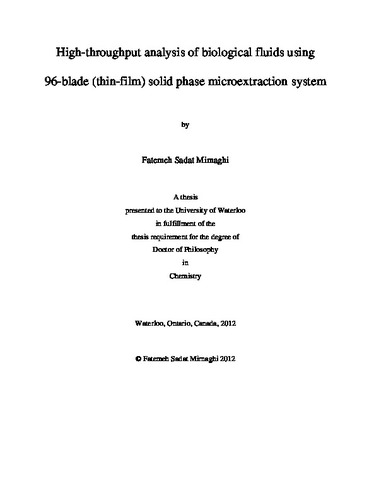| dc.contributor.author | Mirnaghi, Fatemeh Sadat | |
| dc.date.accessioned | 2013-01-07 14:16:03 (GMT) | |
| dc.date.available | 2013-01-07 14:16:03 (GMT) | |
| dc.date.issued | 2013-01-07T14:16:03Z | |
| dc.date.submitted | 2012 | |
| dc.identifier.uri | http://hdl.handle.net/10012/7175 | |
| dc.description.abstract | The initial research of this thesis involves the evaluation of different strategies for developing diverse chemistries of highly stable coatings for the automated 96-blade (thin-film) solid phase microextraction (SPME) system. Thin-film geometry increases the volume of extractive phase, and consequently improves the sensitivity of the analysis. Sol-gel technology was used for the preparation of octadecyl (C18)-silica gel thin-film coating. The evaluation of the C18-silica gel SPME extractive phase resulted in stable physical and chemical characteristics and long-term reusability with a high degree of reproducibility.
Biocompatible polyacrylonitrile (PAN) polymer was used for the preparation of particle-based extractive phases in order to improve the biocompatible characteristics of SPME coatings for the extraction from biological samples.
Three different immobilization strategies were evaluated for developing highly stable coatings for the automated 96-blade SPME system. The spraying was found to be the optimal method in terms of stability and reusability for long-term use.
The optimized C18-PAN coating demonstrated improved biocompatibility, stability, and reusability for the extraction of benzodiazepines from human plasma in comparison with those of C18-silica gel coating.
To improve the biocompatible properties of the C18-PAN SPME coating for long-term direct analysis from whole blood, different modification strategies were studied and evaluated. The modification of the coating with an extra layer of biocompatible polyacrylonitrile resulted in significant improvement in the blood compatibility in long-term use.
‘Extracted blood spot’ (EBS) sampling was introduced as a novel approach to overcome the limitations of dried blood spot sampling. EBS includes the application of a biocompatible SPME coating for spot sampling of blood or other biofluids. The compatibility of EBS sampling with different analytical methods was demonstrated. The utilization of EBS as a fast sampling and sample preparation method resulted in a significant reduction of matrix effects through efficient sample clean-up.
Modified polystyrene-divinylbenzene (PS-DVB)-PAN and phenylboronic acid (PBA)-PAN 96-blade SPME coatings were developed and evaluated for the extraction of analytes in a wide range of polarity. These coatings demonstrated efficient extraction recovery for both polar and non-polar groups of compounds, and presented chemical and mechanical stabilities and reproducible extraction efficiencies for more than 100 usages in biological sample. | en |
| dc.language.iso | en | en |
| dc.publisher | University of Waterloo | en |
| dc.subject | Sample preparation | en |
| dc.subject | Solid phase microextraction | en |
| dc.subject | Liquid chromatography-mass spectrometry | en |
| dc.subject | Automation | en |
| dc.subject | High throughput analysis | en |
| dc.title | High-throughput analysis of biological fluids using 96-blade (thin-film) solid phase microextraction system | en |
| dc.type | Doctoral Thesis | en |
| dc.pending | false | en |
| dc.subject.program | Chemistry | en |
| uws-etd.degree.department | Chemistry | en |
| uws-etd.degree | Doctor of Philosophy | en |
| uws.typeOfResource | Text | en |
| uws.peerReviewStatus | Unreviewed | en |
| uws.scholarLevel | Graduate | en |

